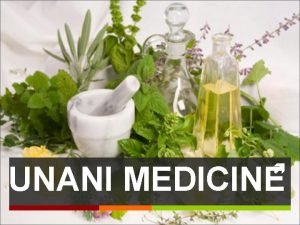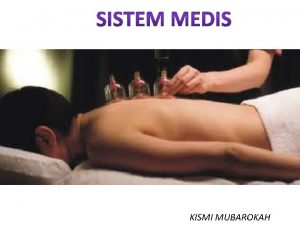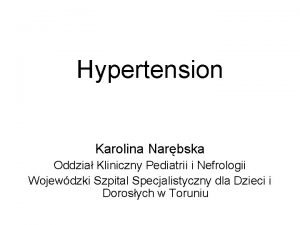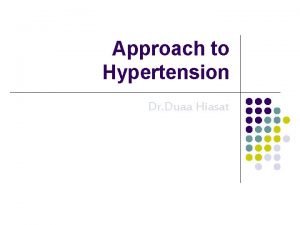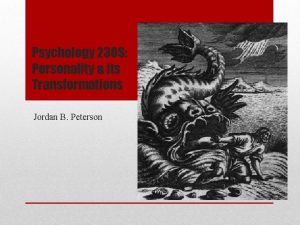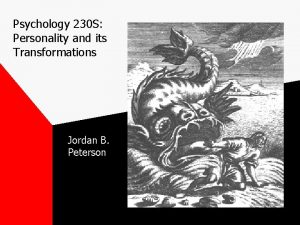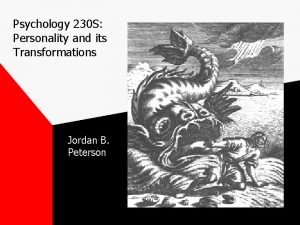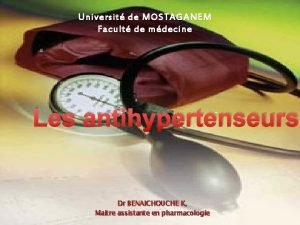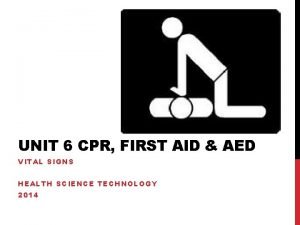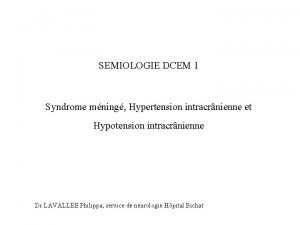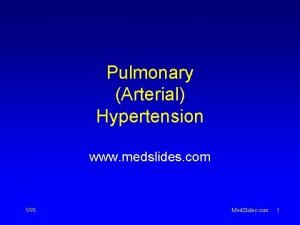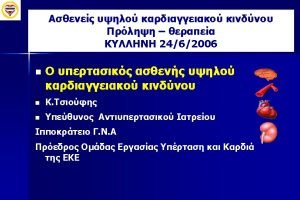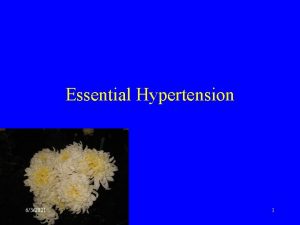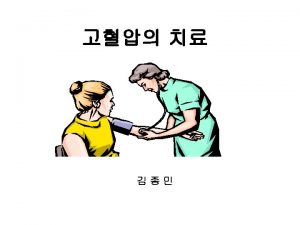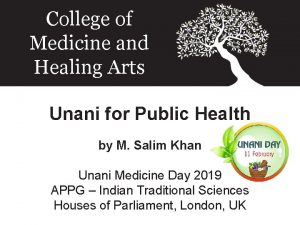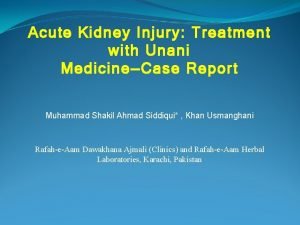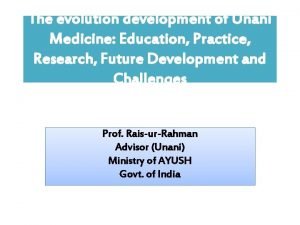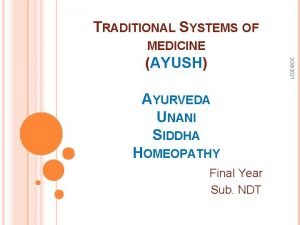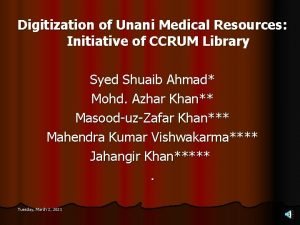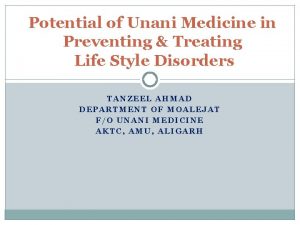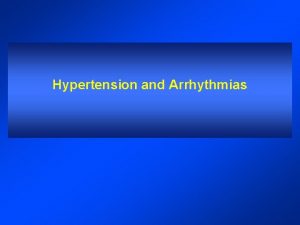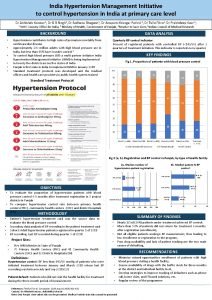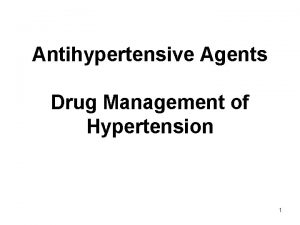HYPERTENSION AND ITS UNANI MANAGEMENT Introduction Hypertension is





















- Slides: 21

HYPERTENSION AND ITS UNANI MANAGEMENT

Introduction �Hypertension is defined as the presence of a blood pressure elevation to a level that places patients at increased risk for target organ damage in several vascular beds including the retina, brain, heart, kidneys and large arteries.

WHO/ISH grading of HTN

JNC 8 grading of HTN Classification SBP (mm Hg) DBP (mm Hg) Normal < 120 AND < 80 Prehypertension 120 - 139 OR 80 - 89 Stage 1 HTN 140 - 159 OR 90 - 99 Stage 2 HTN ≥ 160 OR ≥ 100

Classification of HTN 1) Primary / Essential / Idiopathic HTN: When BP is elevated without an evident cause it is known as essential hypertension, 80 - 95% of HTN is Idiopathic. 2)Secondary hypertension: it is the arterial hypertension of known cause. It accounts 5 - 20% of all cases of systemic hypertension.

Causes of secondary hypertension Renal : Ø renal vascular disease Ø parenchymal renal disease(glomerulonephritis) Ø Polycystic kidney disease q Endocrine : Ø Adrenal- primary aldosteronism, cushing’s syndrome, phaeochromocytoma, Congenital adrenal hyperplasia Ø Hyperthyroidism Ø Hypothyroidism Ø Acromegaly q

Cont…. q Drugs Ø High dose estrogen Ø Adrenal steroids Ø Decongestants Ø Appetite suppresants Ø Tricyclic antidepressants Ø Erythropoietin Ø NSAIDs q Coarctation of aorta q Obstructive sleep apnoea q Preeclampsia / eclampsia

Diagnosis �BP elevation is usually discovered in asymptomatic individuals during routine health visits. �Secondary hypertension should be considered in the following situations: �Age below 35 and above 65 years of age �First time presenting with severe hypertension > 180/110 mm hg. �Difficult to control on 2 or more drugs. �First time presenting with hypertension with deranged kidney functions. �Patient’s renal function starts to derange on ACE inhibitors and ARBs.

Investigations q. First line: �Complete blood count �Urine – routine & microscopic �RFT �Blood sugar level �Lipid profile �ECG �Serum electrolytes �Thyroid profile �Fundus examination

q. Second line : �USG abdomen for kidney size, cortical thickness and corticomedullary differentiation �Renal artery colour doppler for stenosis �Renal angiogram �MRI angiography �PAC / PRA ratio �Urinary cortisol level � 24 hrs urinary catecholamines �CT scan abdomen and thorax �Echocardiography

Unani concept Ø In ancient unani literature, hypertension has not been described as separate entity but unani physicians were all aware of zaghtuddam(B. P). They regarded zaghta-e-qawi as Systolic & zaghta-e–inbesati as diastolic blood pressure. Ø Most of the unani physicians like Rhaze, Majoosi, Ibn sina , Ibn rushd , Al jirjani has given the concept of hypertension as imtila ba hasbul auiya and said that this occurs due to su-e-mizaj damwi and comes under the heading of imtela. Ø Unani physicians were familiar to manifestations of hypertension.

Cont… Ø Some of them described that increased vascular pressure is due to increased blood volume & decreased in lumen of blood vessels. Ø Som e scholars believed that hypertension is a manifestation of yaboosat-e-mizaj (dryness in arteries)which is the main cause of atherosclerosis (tasallub –e-sharaeen).

Cont… Ø Clinical features of imtela in classical unani literature correspond with clinical features as encountered in the patient of hypertension. Therefore we can correlate both these terms imtela & hypertension to the same content. Later on unani physicians translated hypertension as zaghtuddam qawi. Ø As per unani literature , imtela is of two types • Imtela ba hasbul auiya (repletion in regard to vessels) • Imtela ba hasbul quwa (repletion in regard to vitality)

Sign and symptoms of imtela �Heaviness of body / lethargy �Headache �Redness of complexion �Engorgement of vessels �Fullness of pulse �Epistaxis �Hematuria �Palpitation �Blurring of vision

Management q. Ilaj bil ghiza q. Ilaj bil tadbeer q. Ilaj bil dawa Ø Ilaj bil ghiza / dietotherapy taqleel ghiza and mulattif ghiza are used. Dietary salt reduction to < 6 g Na. Cl / day. Adapt DASH diet, increased potassium intake and overall healthy dietary pattern.

Ø Ilaj bil tadbeer / regimental therapy �Regular aerobic activity e. g brisk walking for 30 min/day 6 -7 days a week. �The regimental therapies mentioned in unani system of medicine are basically applied for istefragh. These include – �Fasd ( venesection) �Hijama bil shurt – Razi and Al Zohrawi described the application of cupping in intra scapular region for imtela dam with khafqan. �Tareeq ( diaphoresis) �Ishaal ( purgation)

Ø Ilaj bil dawa / pharmacotherapy �Mudirrat bol e. g tukhm khayarain, kharpaza, khurfa etc are used. �Musakkinat and munawwimat e. g tukhm khash, kahu, kishneez khushk, gul e neelofer, asrol etc are used. �Mufarreh wa muqawwi qalb e. g abresham, sandal safed, zafran, mushk, gaozaban, badranjboya etc are used. �Mufatteh urooq e. g chhaal arjun, sumbul teeb, parsyaosha, lehsun etc are used. �Several compound formulations e. g qurs dawaul shifa, khamira abresham sada, safoof musakkin are also used.




 Unani meaning
Unani meaning Sistem medis regional
Sistem medis regional Hypertension
Hypertension Stage 1 hypertension
Stage 1 hypertension Malignant hypertension management
Malignant hypertension management Nursing management of portal hypertension
Nursing management of portal hypertension They accuse me of being dark in their free city
They accuse me of being dark in their free city Its halloween its halloween the moon is full and bright
Its halloween its halloween the moon is full and bright Symptoms of portal hypertension
Symptoms of portal hypertension When a train increases its velocity, its momentum
When a train increases its velocity, its momentum Sunny cloudy rainy snowy windy
Sunny cloudy rainy snowy windy If its a square it's a sonnet summary
If its a square it's a sonnet summary Its not easy but its worth it
Its not easy but its worth it Custom reader joseph rychlak
Custom reader joseph rychlak Precosmogonic
Precosmogonic Personality and its transformations
Personality and its transformations Diueritique
Diueritique 6 vital signs first aid
6 vital signs first aid Hypertension
Hypertension Jnc7
Jnc7 Hypertension intracrânienne
Hypertension intracrânienne Pah vs pulmonary hypertension
Pah vs pulmonary hypertension
